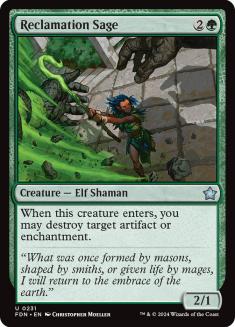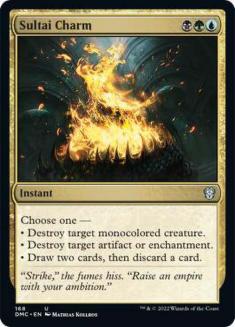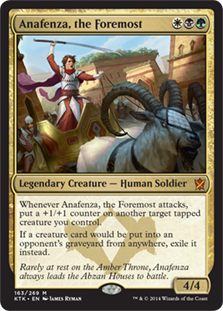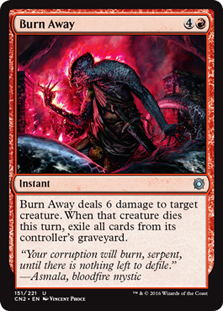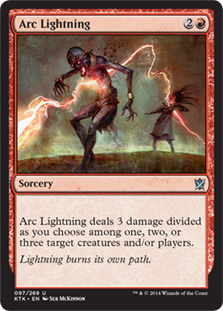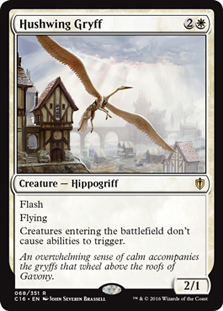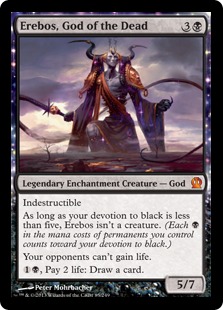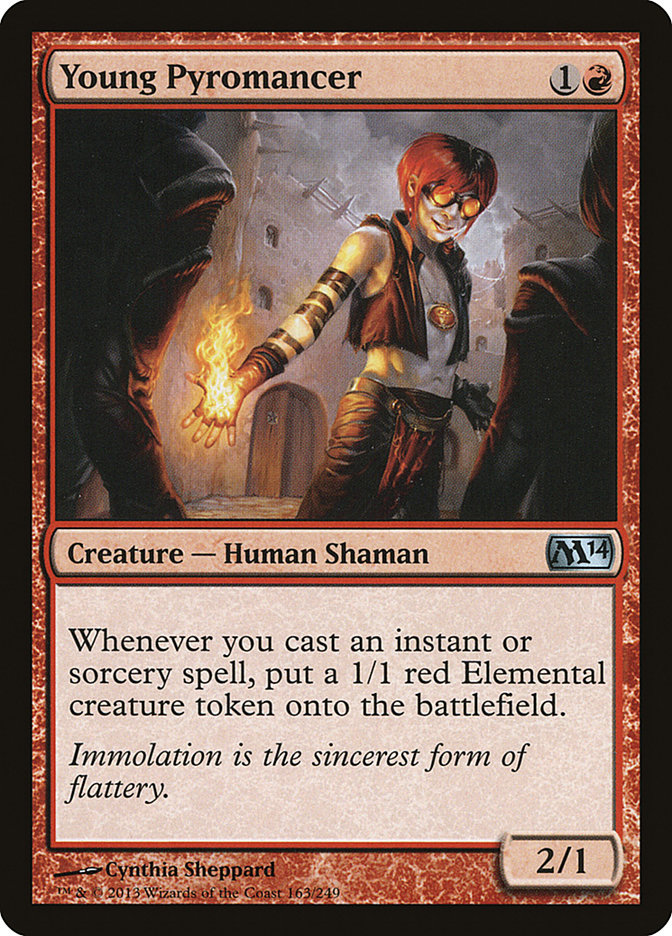Open Series events in Atlanta are my favorite. Not only are they close by, but they bring out of the woodwork a lot of fine people who normally aren’t
interested in travelling extensively for Magic. I usually don’t take them too seriously since there’s so much great company to be had, but this one was a
little different.
I didn’t think I would be in attendance on Saturday due to school restraints, but I decided to come last minute and committed to waking up early and
driving myself. My deck was a bit of a brew. I wanted to keep trying to explore Chord of Calling as a concept, this time moving towards Abzan colors (a lot
of it had to do that the cards were readily available and the fact that it was last minute) as more of a Standard midrange shell that could utilize Hornet
Queen. Of course, in the process, I neglected Tyler Wilkerson’s list for Sultai Reanimator that took down the tournament in the hands of John Farrow, so
good beats.
Creatures (27)
- 4 Hornet Queen
- 2 Elvish Mystic
- 4 Sylvan Caryatid
- 4 Courser of Kruphix
- 4 Satyr Wayfinder
- 3 Doomwake Giant
- 1 Pharika, God of Affliction
- 1 Soul of Innistrad
- 4 Sidisi, Brood Tyrant
Lands (23)
Spells (10)
Sideboard

Standard is in a bit of a strange place. I thought that I would be going over the top of my opponents, but they seemed to all have gotten the memo. Brad
Nelson’s branching out in Richmond has likely changed the format in a way that might not be so apparent at first glance. After playing against an Abzan
splash Dig Through Time and Disdainful Stroke deck, I’m convinced there are no sacred cows. Sultai and Abzan Reanimator are currently at the top of the
ladder for the best “out-midrange your opponent” deck, but what are the implications? If traditional decks like Mardu and Abzan Midrange can’t compete with
the power level discrepancies of decks splashing more colors or utilizing their graveyard to play the long game, then the metagame is ripe for someone
(see: Tom Ross Season Two Invitational) to go completely under all of these inbred strategies. In turn, this would make a deck like Mardu an excellent
choice if one were to suspect resurgence in highly aggressive decks. I believe we are in the midst of a cycle and succeeding in Standard in the following
weeks will be about accurately predicting the sweet spot in the metagame.
Some underrated and underplayed cards it right now include:
I was in a bit of a strange place mentally going into Legacy for SCG Atlanta, since I felt like I had something to prove after my previous article. I
shuffled up my exact posted 75, since I hadn’t had a lot of time to explore any other variations.
Creatures (8)
Lands (17)
Spells (35)

Although I had a particularly difficult day of Magic, I think it’s most important to focus on my losses:
Round 5 vs. Shardless Sultai
I played this round against a local friend of mine, Justin. The first game was an interesting affair of us trading resources aggressively, and I did not
have a good handle on what his deck was capable of yet. After a fortunate series of events, I had a Snapcaster Mage and Sensei’s Divining Top in play with
a meager life total to his Ancestral Visions ticking down and nothing of consequence. Of course, it only takes one draw step to change that and after
finding a Treasure Cruise, casting a Shardless Agent, and cascading into Ancestral Visions in the same turn, Justin suddenly had six cards in hand, and I
was quite dead. Needless to say his deck intrigued me.
In the second game I had maneuvered a True-Name Nemesis into play with a Jitte, my last two cards in hand being Force of Will and Dig Through Time. My
opponent had two cards in hand, and played Night of Souls’ Betrayal. Do you Force? At the time, my line of thinking was that the only way I could win the
match (there were less than 20 minutes left in the round) was to aggressively close out the game within the next three turns and hope that game 3 was not
an extremely grindy affair. My Stoneforge component seemed capable of stealing a game quickly against a relatively removal light strategy. Ultimately, I
chose to, and he cast a Liliana of the Veil the next turn effectively ending the match. I think I would still make the same decision again, but it bothers
me a bit.
Round 8 vs. Elves
After splitting two relatively non-competitive games in our win-and-in, we both started game 3 with a mulligan to six. After stopping the unfair component
of his deck, and some Abrupt Decays trading for my Counterbalance and Containment Priest, we were stuck in the part of the game I am all too familiar with:
I need to wrestle my Jitte into play past his Quiron Ranger/Wirewood Symbiote interactions while staving off his beatdown plan. Unfortunately, a Deathrite
Shaman was putting me precariously low on life. On the critical turn of the game, my hand contained Batterskull, Umezawa’s Jitte, and a Dig Through Time
with five lands in play (two uncracked fetches among them), and one card in the graveyard. On my opponent’s end step I could choose to deploy either of my
equipment with my active Stoneforge, or cast Dig Through Time where any removal spell will allow me to connect with Jitte. Further, Supreme Verdict would
destroy six of his permanents leaving him with just a Bayou. I chose to cast Dig Through Time which revealed three non-cantrip blue cards and four lands.
The top of my deck offered no help, and two turns later I succumbed to Deathrite Shaman.
I’m well used to driving the two hours home from Atlanta alone, and it often gives me time to reflect. Sunday night I was pretty upset, given how unlucky
it was to completely brick eight cards deep. However, on Monday, I realized that I messed up. You might have noticed a Sword of Feast and Famine in my
decklist, and that Batterskull in my hand. While it sounds obvious to bring in Sword of Feast and Famine in the Elves matchup, it’s not something I am
accustomed to doing. In the past, particularly with Jeskai Delver, I was never interested in using the Sword, since when it was time to turn to a Jitte
plan I often had Insectile Aberrations or True-Name Nemesis ready to connect. By not putting in the reps or imagining how the matchup had conceptually
changed between the two decks, I did not make the transition, realizing that it would be much harder for me to effectively turn the corner and require
additional amounts of removal spells and other resources to utilize my equipment effectively. Yes, the vast majority of the time I win that game post Dig
Through Time, but should I have ever needed another draw step after resolving my second Stoneforge Mystic? Based on the texture of the game, probably not,
and I have to take responsibility for that.
As an aside, I think it is important to touch on what learning in Magic actually is. Developing as player isn’t about not messing up, that’s impossible.
Rather, it’s about striving to never let having something under your control happen to you twice.
Despite my short comings, I still came out with a top 32, and I feel the deck is excellent. Some specific things I noticed about myself were that I don’t
have the physical reps with Sensei’s Divining Top. I am generally comfortable with the speed of my decision making, but my mechanics with Top, dexterously,
need to be improved. I was often bordering on going to time every round and that is an issue. That being said, I would recommend this deck to anyone who
has Jeskai experience of just about any flavor, assuming they put in the practice, for the Season Four Invitational.
Rather than posting a decklist, I want to discuss some specific choices and alternates
The Mana
Twenty lands felt right. The deck is more mana hungry than the Pyromancer iterations with the Top + Counterbalance package, and desires a high number of
fetchlands and access to basics. The main concern is the fourth Volcanic Island over the third Island or fourth Tundra. The deck is not incredibly reliant
on red, but I do like the ability to set up your mana to fetch basic Plains, which is more important, and still have access to all your colors.
Creatures
The only creature I would consider changing is the second Snapcaster Mage. He, unfortunately, is rather polarized and is either excellent or you just do
not have time to deploy him. In combo matchups he is not particularly desirable, and the fact that he essentially costs three mana creates some tension as
to whether he would be better served as a third True-Name Nemesis in a lot of creature matchups. However, the upside of being an instant speed piece of
redundancy that gives you a great plan going late with Dig Through Time (delve can be used with Flashback) certainly earns at least a single spot.
Spells
My only concerns are Pyroblast, Counterspell, and Council’s Judgment. I am pretty firm that Pyroblast should be Spell Pierce. The ability for the deck to
lock up so many game 1s through the use Counterbalance leads me to believe that it is more important to have the most versatile card. Spell Pierce would be
a huge asset to improving your positioning against Elves and fringe decks in the first game.
Counterspell, despite being great in the lategame and one of the better cards to Dig into, is rather inefficient and horrible to have on the draw. It
probably still deserves its spot for now, but I would keep an eye on it. It is also worth nothing that it would likely need to be replaced with another
two-drop.
Council’s Judgment isn’t particularly good at doing anything and is difficult to cast, but it does everything and gives you draws to random troublesome
permanents. If a Snapcaster was cut, I could definitely see a third True-Name replacing Judgment.
The Sideboard
Flusterstorm, Containment Priest, Supreme Verdict, Wear//Tear, and some number of Blasts are all excellent. Perhaps the deck would like to board in a
leaner removal spell like a Pyroclasm or Forked Bolt to remain competitive on the draw when facing board position creature decks. A huge concern for me is
that Abrupt Decay midrange decks like Jund and Shardless Sultai are extremely difficult to beat when they can easily target all three of your major
components: Counterbalance, equipment, and True-Name Nemesis. Incorporating an unblastable midrange threat like Elspeth, Knight-Errant could go a long way
towards wrestling back inevitability from these decks and grant a great plan going long alongside Dig through Time. Meddling Mage felt weaker than usual.
Without the ability to look at your opponent’s hand, you are required to know exactly what your gameplan is and how to execute precisely. I think a third
Containment Priest would be stronger. The deck certainly wants access to some graveyard hate. I could see a world where you are comfortable boarding out
your Dig Through Times for Rest in Peace, which also have applications against Tarmogoyf/Deathrite decks, but it’s a bold strategy. Further, it is nice
being able to board in Relics against Treasure Cruise matchups where Rest in Peace would be poor.
I want to close by talking about playing against Young Pyromancer decks:
These are likely the most common matchups you will face and the main draw to playing Top-Blade. It is most important to realize that you are the control
deck. Your life total is something to be managed, in particular against U/R Delver, and the main goal of the game is eliminating their threats and keeping
Young Pyromancer and his buddies off the board. Patience is of utmost importance, and at any stage in the game where you aren’t under pressure, you should
probably just pass. Draw step for draw step your cards are better and your plan trumps theirs. There are, of course, considerations to be made like Price
of Progress or inevitable equipment battles, but for the most part your opponents will be Treasure Cruising into mostly air, and the main goal of the game
is to establish the Counterbalance lock. Never deploy Counterbalance as a test spell early in the game unless you have multiple copies. Stoneforge Mystic
is unique in that it cannot be Spell Pierced or Red Blasted, so it is acceptable to cast on turn 3 with the intention of tying up your opponent’s mana by
either forcing them to cast or look for removal spells since Batterskull superiority is still a route to victory. However, if at any point you are given
the choice between advancing your board or killing their creature, it is extremely likely the latter is the correct choice. Do not under any circumstances
let your removal spells get Dazed or Spell Pierced if it is at all possible. Using your Snapcaster Mages and Dig Through Times as test spells to let you
untap and land the lock are also important considerations. While it may feel like drawing a ton of cards is more desirable, in reality Counterbalance just
locks almost everything relevant they can do out of the game and is one of the only cards that matters besides True-Name Nemesis.
Unfortunately, I will be chasing Pro Points in Baltimore so my opportunities to play Legacy are dwindling until next year. I hope to see some folks doing
well with this Stoneblade variation at the Season Four Invitational.


